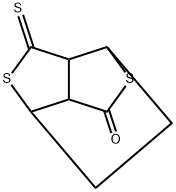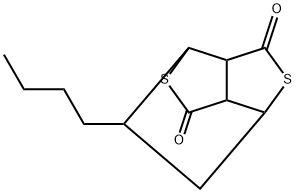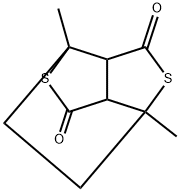1,8-Octanedithiol
Synonym(s):1,8-Dimercaptooctane
- CAS NO.:1191-62-4
- Empirical Formula: C8H18S2
- Molecular Weight: 178.36
- MDL number: MFCD00003574
- EINECS: 214-738-8
- SAFETY DATA SHEET (SDS)
- Update Date: 2024-11-04 13:44:46

What is 1,8-Octanedithiol?
Chemical properties
liquid
Chemical properties
1,8-Octanedithiol has a sulfurous, meaty odor. FEMA indicates that total dithiol added to any food should not exceed 1.0 ppm
The Uses of 1,8-Octanedithiol
OCT may be used as a processing additive that can functionalize the electrode layer to enhance the power efficiency of P3HT:PCBM solar cells. It may also be used to form a SAM on gold electrodes to enhance the electrochemical properties.
What are the applications of Application
1,8-Octanedithiol is a compound used in self-assembled monolayers (SAMs)
Definition
ChEBI: 1,8-Octanedithiol is an alkanethiol.
General Description
1,8-Octanedithiol (OCT) is an alkanedithiol, which forms a self-assembled monolayer (SAM) on a variety of metal surfaces. OCT contains linearly arranged carbon-carbon bonds (C?C) and two sulfur atoms at the end facilitating the attachment with the surface atoms of the substrates. It mainly forms an organo-metallic system, which can be used to improve the electron transport medium for a wide range of electronic applications.
Properties of 1,8-Octanedithiol
| Melting point: | 1°C(lit.) |
| Boiling point: | 269-270 °C (lit.) |
| Density | 0.97 g/mL at 25 °C (lit.) |
| refractive index | n |
| FEMA | 3514 | 1,8-OCTANEDITHIOL |
| Flash point: | >230 °F |
| form | Liquid |
| pka | 10.19±0.10(Predicted) |
| color | Colorless to pale yellow |
| Odor | at 0.10 % in propylene glycol. sulfurous meaty mushroom earthy |
| Sensitive | Air Sensitive |
| JECFA Number | 541 |
| BRN | 1735431 |
| Stability: | Stable. Combustible. Incompatible with strong oxidizing agents, strong bases. |
| CAS DataBase Reference | 1191-62-4(CAS DataBase Reference) |
Safety information for 1,8-Octanedithiol
| Signal word | Warning |
| Pictogram(s) |
 Exclamation Mark Irritant GHS07 |
| GHS Hazard Statements |
H302:Acute toxicity,oral H315:Skin corrosion/irritation H319:Serious eye damage/eye irritation |
| Precautionary Statement Codes |
P264:Wash hands thoroughly after handling. P264:Wash skin thouroughly after handling. P270:Do not eat, drink or smoke when using this product. P280:Wear protective gloves/protective clothing/eye protection/face protection. P330:Rinse mouth. P501:Dispose of contents/container to..… |
Computed Descriptors for 1,8-Octanedithiol
New Products
4-Fluorophenylacetic acid 4-Methylphenylacetic acid N-Boc-D-alaninol N-BOC-D/L-ALANINOL Tert-butyl bis(2-chloroethyl)carbamate 3-Morpholino-1-(4-nitrophenyl)-5,6-dihydropyridin- 2(1H)-one Furan-2,5-Dicarboxylic Acid Tropic acid S-2-CHLORO PROPIONIC ACID ETHYL ISOCYANOACETATE 2-Bromo-1,3-Bis(Dimethylamino)Trimethinium Hexafluorophosphate (6-METHYL-[1,3]DITHIOLO[4,5-b]QUINOXALIN-2-ONE INDAZOLE-3-CARBOXYLIC ACID 4-IODO BENZOIC ACID (2-Hydroxyphenyl)acetonitrile 4-Bromopyrazole 5,6-Dimethoxyindanone 2-(Cyanocyclohexyl)acetic acid 4-methoxy-3,5-dinitropyridine 2-aminopropyl benzoate hydrochloride 1-(4-(aminomethyl)benzyl)urea hydrochloride diethyl 2-(2-((tertbutoxycarbonyl)amino) ethyl)malonate tert-butyl 4- (ureidomethyl)benzylcarbamate Ethyl-2-chloro((4-methoxyphenyl)hydrazono)acetateRelated products of tetrahydrofuran








You may like
-
 1,8-Octanedithiol CAS 1191-62-4View Details
1,8-Octanedithiol CAS 1191-62-4View Details
1191-62-4 -
 1,8-Octanedithiol CAS 1191-62-4View Details
1,8-Octanedithiol CAS 1191-62-4View Details
1191-62-4 -
 1975-50-4 98%View Details
1975-50-4 98%View Details
1975-50-4 -
 2-HYDROXY BENZYL ALCOHOL 98%View Details
2-HYDROXY BENZYL ALCOHOL 98%View Details
90-01-7 -
 2-Chloro-1,3-Bis(Dimethylamino)Trimethinium Hexafluorophosphate 221615-75-4 98%View Details
2-Chloro-1,3-Bis(Dimethylamino)Trimethinium Hexafluorophosphate 221615-75-4 98%View Details
221615-75-4 -
 61397-56-6 CIS BROMO BENZOATE 98%View Details
61397-56-6 CIS BROMO BENZOATE 98%View Details
61397-56-6 -
 14714-50-2 (2-Hydroxyphenyl)acetonitrile 98+View Details
14714-50-2 (2-Hydroxyphenyl)acetonitrile 98+View Details
14714-50-2 -
 118753-70-1 98+View Details
118753-70-1 98+View Details
118753-70-1